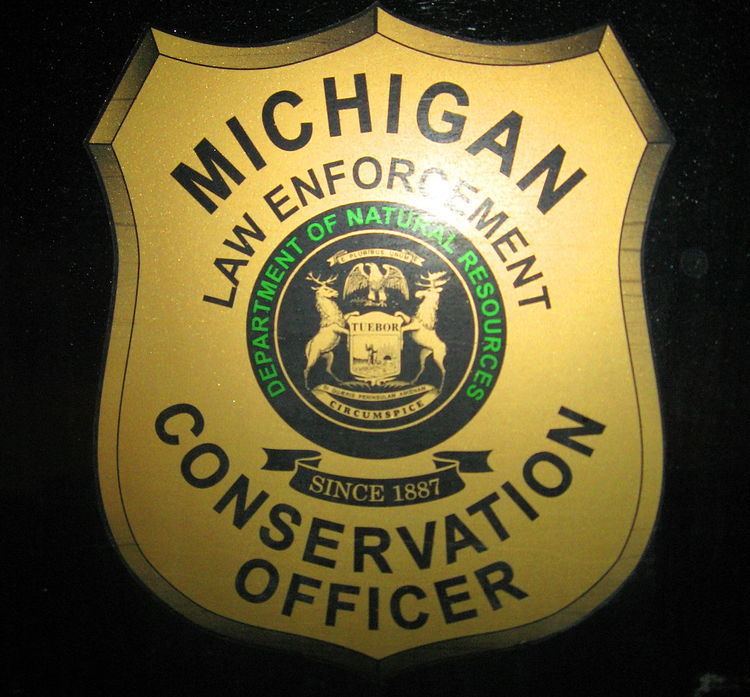Abbreviation LED Employees 192 | Formed 1887 | |
 | ||
Annual budget $29,018,100.00 (2013-2014) Legal personality Governmental: Government agency | ||
Michigan Conservation Officers are conservation officers who are the enforcement branch of the Michigan Department of Natural Resources. Their primary duty is to enforce the environmental laws in the State of Michigan. Michigan Conservation Officers are fully commissioned peace officers and are empowered to enforce all the laws of the state of Michigan, with the exception of some traffic law. The definition of peace officer under traffic law does not include 'Conservation Officer' and as such, Conservation Officer's are only able to execute traffic stops for violations of general state law or acts ancillary to hunting/conservation law.
Contents
The Michigan Conservation Officers work with local police departments, sheriff's departments, the Michigan State Police, the U.S. Coast Guard, the U.S. Customs and Border Protection, the U.S. Forest Service Law Enforcement Division and other state, federal, and foreign agencies.
History
"Early Michigan citizens recognized the rich and vast natural treasures surrounding them and the need for their conservation and protection. The result was the nation's first salaried game warden, William Alden Smith, who was appointed in 1887.
Warden Smith was charged principally with appointing deputies for the enforcement of fish and game regulations. The mission of the DNR Law Enforcement Division has expanded substantially since Smith's appointment and now includes protection of all natural resources and the environment, as well as the health and safety of the public.
Today, "Conservation Officers" and other noncommissioned support staff direct their efforts to a wide array of responsibilities designed to support this broad mission. Enforcement, Education, Recreational Safety and Public Outreach represent some of the general categories of services.
Structure
Michigan Conservation Officers fall under the Law Enforcement Division of the Michigan Department of Natural Resources. Some states including Oregon and Alaska include environmental law enforcement under the Department of State Police. This allows resources to be combined and saves the states money by eliminating duplicate services. Combining the two departments also has some disadvantages. Most states don't combine the two departments. The Law Enforcement Division is broken down into a number of subsections. The subsections include:
Personnel
The Law Enforcement Division of the Michigan Department of Natural Resources has approximately 192 officers.
They are represented in collective bargaining by a union, the Michigan Conservation Officer Association. The last time the Law Enforcement Division (LED) of the Michigan Department of Natural Resources held a recruit academy was 2014. The academy concluded June 2014. At that time they added 23 new conservation officers.
Transportation
Michigan conservation officers use the Chevrolet Silverado and Chevrolet Tahoe as patrol vehicles. They also use patrol boats, both motorized and human-powered, that range in size when they patrol the Great Lakes, inland lakes, rivers, and streams. Other vehicles used include snowmobiles and All Terrain Vehicles (ATVs).
Fallen Officers
From 1908 to date the Michigan Conservation Officers have lost 13 officers in the line of duty. The sacrifice of these officers are customarily recognized on the National Law Enforcement Officers Memorial or at North American Game Warden Museum on the Jurisdictional Plaque. There are also individual memorials scattered around the state.
Training
In January 2014 the MDNR Law Enforcement Division commenced its first academy since 2007 with 31 recruits. This ended a nearly 7-year gap in recruit schools. During the gap, caused by budgetary issues, once an individual was selected for the position of Conservation Officer and the individual was not certified by MCOLES the MDNR paid the individual to complete the required MCOLES Academy. They then would complete the MDNR Environmental Law Enforcement courses. If the individual was MCOLES certified the individual would go through training courses focusing on Environmental Law Enforcement.
Once selected by the Department of Natural Resources through a rigorous selection process the recruits go through an intense 22-week live in training period. The live-in training is held at the Michigan State Police training facility in Lansing. Once completed, the recruits are then fully commissioned conservation officers. After the training, the new officers will be assigned a field-training officer for 18 weeks at a variety of locations around the state. Once the probation period is completed, the officers will be assigned to one of the 83 counties in Michigan. Michigan Conservation Officers are certified by the Michigan Commission on Law Enforcement Standards or MCOLES. [1]
Other
MDNR Report All Poaching Hotline RAP 1-800-292-7800
